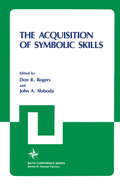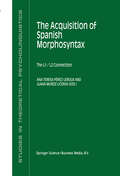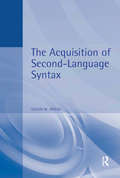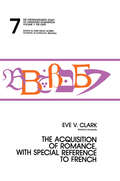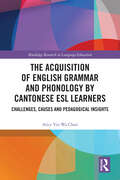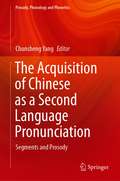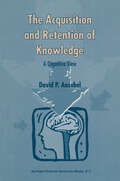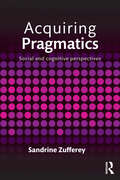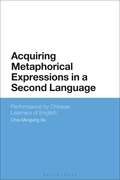- Table View
- List View
Across the Hellespont: A Literary Guide to Turkey
by Richard StonemanTurkey lies at the crossroads of history. For millennia, Anatolia has been crossed and re-crossed by waves of conquering civilizations - Hittites, Persians, Romans and Ottomans - who have created a country as varied as it is possible to find in the world. With a climate and landscape as diverse as its past, Turkey has provided an alluring and yet sometimes challenging destination for westerners throughout the ages. This, and the hospitality of its people has ensured that countless visitors, from classical times to the present, have fallen under the spell of Turkey.'Across the Hellespont' describes in lively detail the remarkable literature which Turkey has inspired for two thousand years. At a time when Turkey's position on the fringe may be set to change to a deeper involvement in Europe, the need for Europeans to understand the country is even more compelling. The range of travel writing represented in this book shows how, while political circumstances may change, the lure of Turkey remains constant.
Across Meridians: History and Figuration in Karen Tei Yamashita’s Transnational Novels (Asian America #74)
by Jinqi LingOver the course of the last two decades, novelist Karen Tei Yamashita has reshaped the Asian American literary imagination in profound ways. In Across Meridians, Jinqi Ling offers readers the most critically engaged examination to date of Yamashita's literary corpus. Crafted at the intersection of intellectual history, ethnic studies, literary analysis, and critical theory, Ling's study goes beyond textual investigation to intervene in larger debates over postmodern representation, spatial materialism, historical form, and social and academic activism. Arguing that Yamashita's most important contribution is her incorporation of a North-South vector into the East-West conceptual paradigm, Ling highlights the novelist's re-prioritization, through such a geographical realignment, of socio-economic concerns for Asian American literary criticism. In assessing Yamashita's works as such, Ling designates her novelistic art as a form of new Asian American literary avant-garde that operates from the peripheries of received histories, aesthetics, and disciplines. Seeking not only to demonstrate the importance of Yamashita's transnational art, Ling sets new terms for ongoing dialogues in Asian American literary and cultural criticism. At the same time, he argues for the continuing relevance of Asian American literature as a self-reflexive and self-renewable critical practice.
Across an Inland Sea: Writing in Place from Buffalo to Berlin
by Nicholas HoweHow do the places we live in and visit shape our lives and memories? What does it mean to reside in different locations across the span of a life? In richly textured portraits of places seen from within, Nicholas Howe contemplates how places create and gather their stories and how, in turn, a sense of place locates the stories of our own lives. Howe begins with one of the finest descriptions ever written of Buffalo, that city on an inland sea where he grew up. He gives us a fresh Paris, viewed from the river below. And he depicts Oklahoma as a site of open lands and dislocation--a place of coming and going. Howe then turns to Chartres, a traditional location of pilgrimage, to ask what other sites might still be capable of compelling visitors in secular time. He portrays Berlin as a scene of twentieth-century history--and a city that helped him make sense of his American life. Finally, he writes about Columbus, Ohio, as home. Vividly rendering the places he has known, Howe meditates on the weight of home, the temptations of the metropolis, the fact of dislocation, the unraveling of history, the desire to remake ourselves through voyage, and the wonder of the familiar. In ways that too often elude travel writers, it is place that holds our imagination, that inspires much of our art and literature. Across an Inland Sea evokes the various senses of place that can fill and haunt a life--and ultimately give life its form and meaning.
Across an Inland Sea: Writing in Place from Buffalo to Berlin
by Nicholas HoweHow do the places we live in and visit shape our lives and memories? What does it mean to reside in different locations across the span of a life? In richly textured portraits of places seen from within, Nicholas Howe contemplates how places create and gather their stories and how, in turn, a sense of place locates the stories of our own lives. Howe begins with one of the finest descriptions ever written of Buffalo, that city on an inland sea where he grew up. He gives us a fresh Paris, viewed from the river below. And he depicts Oklahoma as a site of open lands and dislocation--a place of coming and going. Howe then turns to Chartres, a traditional location of pilgrimage, to ask what other sites might still be capable of compelling visitors in secular time. He portrays Berlin as a scene of twentieth-century history--and a city that helped him make sense of his American life. Finally, he writes about Columbus, Ohio, as home. Vividly rendering the places he has known, Howe meditates on the weight of home, the temptations of the metropolis, the fact of dislocation, the unraveling of history, the desire to remake ourselves through voyage, and the wonder of the familiar. In ways that too often elude travel writers, it is place that holds our imagination, that inspires much of our art and literature. Across an Inland Sea evokes the various senses of place that can fill and haunt a life--and ultimately give life its form and meaning.
Across an Inland Sea: Writing in Place from Buffalo to Berlin
by Nicholas HoweHow do the places we live in and visit shape our lives and memories? What does it mean to reside in different locations across the span of a life? In richly textured portraits of places seen from within, Nicholas Howe contemplates how places create and gather their stories and how, in turn, a sense of place locates the stories of our own lives. Howe begins with one of the finest descriptions ever written of Buffalo, that city on an inland sea where he grew up. He gives us a fresh Paris, viewed from the river below. And he depicts Oklahoma as a site of open lands and dislocation--a place of coming and going. Howe then turns to Chartres, a traditional location of pilgrimage, to ask what other sites might still be capable of compelling visitors in secular time. He portrays Berlin as a scene of twentieth-century history--and a city that helped him make sense of his American life. Finally, he writes about Columbus, Ohio, as home. Vividly rendering the places he has known, Howe meditates on the weight of home, the temptations of the metropolis, the fact of dislocation, the unraveling of history, the desire to remake ourselves through voyage, and the wonder of the familiar. In ways that too often elude travel writers, it is place that holds our imagination, that inspires much of our art and literature. Across an Inland Sea evokes the various senses of place that can fill and haunt a life--and ultimately give life its form and meaning.
The Acquisition of Verbs and their Grammar: The Effect of Particular Languages (Studies in Theoretical Psycholinguistics #33)
by Natalia Gagarina Insa GülzowThis volume investigates the linguistic development of children with regard to their knowledge of the verb and its grammar. The selection of papers brings to researchers and in particular psycholinguists empirical evidence from a wide variety of languages from Hebrew, through English to Estonian. The authors interpret their findings with a focus on cross-linguistic similarities and differences, without subscribing to either a UG-based or usage-based approach.
The Acquisition of Verb Placement: Functional Categories and V2 Phenomena in Language Acquisition (Studies in Theoretical Psycholinguistics #16)
by Jurgen M. Meiselother aspects of developing grammars. And this is, indeed, what the contributions to this volume do. Parameterization of functional categories may, however, be understood in different ways, even if one shares the dual assumptions that substantive elements (verbs, nouns, etc. ) are present in all grammars and that X-bar principles are part of the grammatical knowledge available to the child prior to language-specific learning processes. From these assumptions it follows that the child should, from early on, be able to construct projections on the basis of these elements. The role of functional categories, however, may still be interpreted differently. One possibility, first suggested by Radford (1986, 1990) and by Guilfoyle and Noonan (1988), is that children must discover which functional categories (FC) need to be implemented in the grammar of the language they are acquiring. Another possibility, first explored by Hyams (1986), is that a specific category is present in developing grammars but that parameter values are set in a way deviating from the target adult grammar, corresponding, however, to options realized in other adult systems. A third option would be that these categories might be specified differently in developing as opposed to mature grammars. All three are explored in the papers collected in this volume. Before outlining the various hypotheses in more detail, however, I would like briefly to sketch the grammatical context in which the following debate is situated. 2.
The Acquisition of Syntax: Studies in Comparative Developmental Linguistics (Longman Linguistics Library)
by Marc-Ariel Friedemann Luigi RizziThis volume contains a collection of studies that survey recent research in developmental linguistics, illustrating the fruitful interaction between comparative syntax and language acquisition. The contributors each analyse a well defined range of acquisition data, aiming to derive them from primitive differences between child and adult grammar. The book covers cross-linguistic and cross-categorial phenomena, shedding light on major developments in this novel and rapidly growing field. Extensions to second language acquisition and neuropathology are also suggested.
The Acquisition of Syntax: Studies in Comparative Developmental Linguistics (Longman Linguistics Library)
by Marc-Ariel Friedemann Luigi RizziThis volume contains a collection of studies that survey recent research in developmental linguistics, illustrating the fruitful interaction between comparative syntax and language acquisition. The contributors each analyse a well defined range of acquisition data, aiming to derive them from primitive differences between child and adult grammar. The book covers cross-linguistic and cross-categorial phenomena, shedding light on major developments in this novel and rapidly growing field. Extensions to second language acquisition and neuropathology are also suggested.
The Acquisition of Symbolic Skills (Nato Conference Series #22)
by Don Rogers John A. SlobodaThis book is a selection of papers from a conference which took place at the University of Keele in July 1982. The conference was an extraordinarily enjoyable one, and we would like to take this opportunity of thanking all participants for helping to make it so. The conference was intended to allow scholars working on different aspects of symbolic behaviour to compare findings, to look for common ground, and to identify differences between the various areas. We hope that it was successful in these aims: the assiduous reader may judge for himself. Several themes emerged during the course of the conference. Some of these were: 1. There is a distinction to be made between those symbol systems which attempt, more or less directly, to represent a state of affairs in the world (e. g. language, drawing, map and navigational skill) and those in which the representational function is complemented, if not overshadowed, by properties of the symbol system itself, and the systematic inter-relations that symbols can have to one another (e. g. music, mathematics). The distinction is not absolute, for the nature of all symbolic skills is, in part, a function of the structure of the symbolic system employed. Nonetheless, this distinction helps us to understand some common acquisition difficulties, such as that experienced in mathematics, where mental manipulation of symbols can go awry if a child assumes too close a correspondence between mathematical symbols and the world they represent. 2.
The Acquisition of Spanish Morphosyntax: The L1/L2 Connection (Studies in Theoretical Psycholinguistics #31)
by Juana MuñozLiceras Ana TeresaPérez-LerouxRecent developments in linguistic theory, as well as the growing body of evidence from languages other than English, provide new opportunities for deeper explorations into how language is represented in the mind of learners. This collection of new empirical studies on the acquisition of Spanish morphosyntax by leading researchers in the field of language acquisition, specifically contributes to the characterization of the L1 / L2 connection in acquisition. Using L1 and L2 Spanish data from children and adults, the authors seek to address the central questions that have occupied developmental psycholinguists in the final decades of the previous century and that will no doubt continue engaging them into the present one.
The Acquisition of Spanish as a Second Language: Foundations and New Developments
by Kimberly L. Geeslin Avizia Y. Long Megan SolonThis volume offers an introduction to the field of second language acquisition with a particular focus on second language Spanish. It connects key issues in the acquisition of Spanish as a second language to theoretical and empirical issues in the field of second language acquisition more generally by exemplifying central concepts in second language acquisition through the exploration of the most widely researched structures and most recent developments in the field of second language Spanish. It is written for a non-specialist audience, making it suitable for advanced undergraduate and graduate courses and readers, while its treatment of recent empirical developments also makes it of interest to researchers in second language Spanish as well as allied fields.
The Acquisition of Spanish as a Second Language: Foundations and New Developments
by Kimberly L. Geeslin Avizia Y. Long Megan SolonThis volume offers an introduction to the field of second language acquisition with a particular focus on second language Spanish. It connects key issues in the acquisition of Spanish as a second language to theoretical and empirical issues in the field of second language acquisition more generally by exemplifying central concepts in second language acquisition through the exploration of the most widely researched structures and most recent developments in the field of second language Spanish. It is written for a non-specialist audience, making it suitable for advanced undergraduate and graduate courses and readers, while its treatment of recent empirical developments also makes it of interest to researchers in second language Spanish as well as allied fields.
Acquisition of Second Language Syntax
by Susan BraidiThis book deals with the questions asked about the L2 acquisition process within different research paradigms, examines the results found in each approach, and evaluates the contributions of each to our understanding of L2 acquisition of syntax and to possible implications for L2 instruction.
Acquisition of Second Language Syntax
by Susan BraidiThis book deals with the questions asked about the L2 acquisition process within different research paradigms, examines the results found in each approach, and evaluates the contributions of each to our understanding of L2 acquisition of syntax and to possible implications for L2 instruction.
The Acquisition of Scrambling and Cliticization (Studies in Theoretical Psycholinguistics #26)
by Susan M. Powers Cornelia HamannThis collection of papers investigates two specific linguistic phenomena from the point of view of first- and second-language acquisition. While observations on the acquisition of scrambling or pronominal clitics can be found in the literature, up until the recent past they were sparse and often buried in other issues. This volume fills a long-existing gap in providing a collection of articles which focus on language acquisition but at the same time address the overarching syntactic issues involved (for example, the X-bar status of clitics, base-generation vs. movement accounts of scrambling). This volume contains an overview of L1 (and, in one case, L2) acquisition data from a number of different languages including Bernese, Swiss, German, Dutch, English, French, German, Italian, Spanish and Swedish, as well as from several theoretical points of view with these two clause-internal processes at its center. These language acquisition data are considered to be crucial in the validation of analyses of these specific linguistic phenomena in adult grammars. The contributions in this volume include the earliest thoughts in this vein and, for this reason, should be viewed as a starting point for discussions within theoretical linguistics and language acquisition alike.
The Acquisition of Romance, With Special Reference To French: The Crosslinguistic Study of Language Acquisition, Volume 1, Chapter 7
by Eve ClarkFirst published in 1986. This edition offers a grammatical sketch of French, with occasional comments on how other Romance languages diverge from this picture; a brief account of the sources available on language acquisition by children; and a summary of the overall course of development in children acquiring the major Romance languages. The remainder of the review takes up different facets of the language acquisition process in more detail.
The Acquisition of Romance, With Special Reference To French: The Crosslinguistic Study of Language Acquisition, Volume 1, Chapter 7
by Eve ClarkFirst published in 1986. This edition offers a grammatical sketch of French, with occasional comments on how other Romance languages diverge from this picture; a brief account of the sources available on language acquisition by children; and a summary of the overall course of development in children acquiring the major Romance languages. The remainder of the review takes up different facets of the language acquisition process in more detail.
The Acquisition of English Grammar and Phonology by Cantonese ESL Learners: Challenges, Causes and Pedagogical Insights (Routledge Research in Language Education)
by Alice Yin ChanChan’s exploration of the acquisition of English grammar and phonology by Cantonese learners of English as a Second Language (ESL) offers insights into the specific challenges that learners often encounter and posits ways to help them overcome those challenges. Possible sources of the challenges are also examined. The book covers the basic differences between English and Cantonese grammar as well as those between English and Cantonese phonology. Chan discusses the kinds of grammatical and phonological problems that Cantonese ESL learners often have in their acquisition of English. In terms of grammar, various structures are reviewed, including errors which are clearly due to L1 interference and also those which may not be directly L1-related. Learners’ common misconceptions about relevant concepts are also revealed. In terms of phonology, both speech perception and speech production problems at the segmental and suprasegmental levels are examined. For learner problems which may be the result of L1 interference, a contrastive approach is adopted in analysing the cause and nature of the errors. Chan also offers readers pedagogical insights to target common grammatical problems, including the use of an algorithmic approach, the use of a discovery-based consciousness-raising approach and the use of metalinguistic explanations. As far as the learning of English phonology is concerned, she argues that the training of speech production should go hand-in-hand with that of speech perception. Future research can experiment with the proposed teaching ideas with Cantonese ESL learners and learners of other native languages. Researchers and ESL teaching professionals will find the insights and research contained within this volume invaluable when encountering or researching Chinese ESL learners.
The Acquisition of English Grammar and Phonology by Cantonese ESL Learners: Challenges, Causes and Pedagogical Insights (Routledge Research in Language Education)
by Alice Yin ChanChan’s exploration of the acquisition of English grammar and phonology by Cantonese learners of English as a Second Language (ESL) offers insights into the specific challenges that learners often encounter and posits ways to help them overcome those challenges. Possible sources of the challenges are also examined. The book covers the basic differences between English and Cantonese grammar as well as those between English and Cantonese phonology. Chan discusses the kinds of grammatical and phonological problems that Cantonese ESL learners often have in their acquisition of English. In terms of grammar, various structures are reviewed, including errors which are clearly due to L1 interference and also those which may not be directly L1-related. Learners’ common misconceptions about relevant concepts are also revealed. In terms of phonology, both speech perception and speech production problems at the segmental and suprasegmental levels are examined. For learner problems which may be the result of L1 interference, a contrastive approach is adopted in analysing the cause and nature of the errors. Chan also offers readers pedagogical insights to target common grammatical problems, including the use of an algorithmic approach, the use of a discovery-based consciousness-raising approach and the use of metalinguistic explanations. As far as the learning of English phonology is concerned, she argues that the training of speech production should go hand-in-hand with that of speech perception. Future research can experiment with the proposed teaching ideas with Cantonese ESL learners and learners of other native languages. Researchers and ESL teaching professionals will find the insights and research contained within this volume invaluable when encountering or researching Chinese ESL learners.
The Acquisition of Chinese as a Second Language Pronunciation: Segments and Prosody (Prosody, Phonology and Phonetics)
by Chunsheng YangThis book is the first edited book to cover a wide range of issues related to Chinese as a second language (CSL) speech, including tone and segment acquisition and processing, categorical perception of tones, CSL fluency, CSL intelligibility/comprehensibility and accentedness, and pronunciation pedagogy. Moreover, the book addresses both theoretical and pedagogical issues. It offers an essential go-to book for anyone who is interested in CSL speech, e.g. CSL speech researchers, Chinese instructors, CSL learners, and anyone interested in second language speech.
The Acquisition and Retention of Knowledge: A Cognitive View
by D.P. AusubelIn 1963 an initial attempt was made in my The Psychology of Meaningful Verbal Learning to present a cognitive theory of meaningful as opposed to rote verbal learning. It was based on the proposition that the acquisition and retention of knowl edge (particularly of verbal knowledge as, for example, in school, or subject-matter learning) is the product of an active, integrative, interactional process between instructional material (subject matter) and relevant ideas in the leamer's cognitive structure to which the new ideas are relatable in particular ways. This book is a full-scale revision of my 1963 monograph, The Psychology of Meaningful Verbal Learning, in the sense that it addresses the major aforementioned and hitherto unmet goals by providing for an expansion, clarification, differentiation, and sharper focusing of the principal psychological variables and processes involved in meaningful learning and retention, i.e., for their interrelationships and interactions leading to the generation of new meanings in the individual learner. The preparation of this new monograph was largely necessitated by the virtual collapse of the neobe havioristic theoretical orientation to learning during the previous forty years; and by the meteoric rise in the seventies and beyond of constructivist approaches to learning theory.
Acquiring Pragmatics: Social and cognitive perspectives
by Sandrine ZuffereyAcquiring Pragmatics offers a comprehensive synthesis of state-of-the-art research on the acquisition of pragmatics. It introduces the current topics of research in theoretical pragmatics and explores the issues they raise for language acquisition research and the new experimental designs which have been developed to address them. While each chapter covers each topic in depth, it also places a strong emphasis on the underlying methodological aspects of each issue, which will help the reader to develop their own experimental designs. Key topics covered include: The interfaces between pragmatics and language acquisition The social aspects of pragmatic competence The cognitive aspects of pragmatic competence The acquisition of pragmatics in autistic spectrum disorders and second language acquisition Acquiring Pragmatics is key reading for advanced undergraduate and graduate students studying pragmatics and language acquisition.
Acquiring Pragmatics: Social and cognitive perspectives
by Sandrine ZuffereyAcquiring Pragmatics offers a comprehensive synthesis of state-of-the-art research on the acquisition of pragmatics. It introduces the current topics of research in theoretical pragmatics and explores the issues they raise for language acquisition research and the new experimental designs which have been developed to address them. While each chapter covers each topic in depth, it also places a strong emphasis on the underlying methodological aspects of each issue, which will help the reader to develop their own experimental designs. Key topics covered include: The interfaces between pragmatics and language acquisition The social aspects of pragmatic competence The cognitive aspects of pragmatic competence The acquisition of pragmatics in autistic spectrum disorders and second language acquisition Acquiring Pragmatics is key reading for advanced undergraduate and graduate students studying pragmatics and language acquisition.
Acquiring Metaphorical Expressions in a Second Language: Performance by Chinese Learners of English
by Chris Mengying XiaConventional metaphorical expressions are widely used by native speakers in everyday language and have received extensive attention in theoretical semantics and cognitive linguistics. However, how a second language learner can acquire those expressions is left largely unknown. Researchers and language learners face the question: if one has acquired the literal meaning of a word, can they automatically derive the metaphorical meaning? This book provides the answer by placing the question of acquisition of metaphorical expressions in the framework of bilingual lexicon. Assessing whether metaphorical expressions are taken for granted by second language learners, it explores how the metaphorical meaning(s) of a word should be connected in a learner's mental lexicon, and how the cross-linguistic availability of a metaphorical expression could affect the outcome of acquisition of that expression. The book also provides a detailed comparison between metaphorical expressions and other figurative language from both the theoretical and experimental perspectives.







